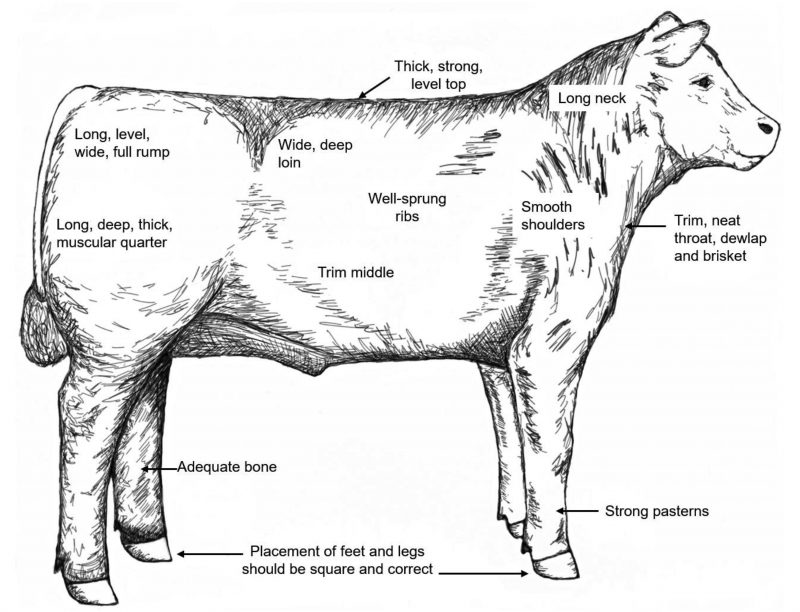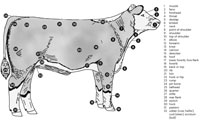
Becoming a top judge takes a tremendous amount of practice. The more you practice, the more proficient you will become.
It is always important to remember that different judges will have different opinions so be prepared to keep an open mind.
When judging make sure you have valid reasons for the placings you have decided upon in case you are called upon to explain your decisions, whether publicly or to an individual.
Always pay attention when reasons are being given by experienced judges so as to improve your knowledge and the terminology to use.
The breeding animal
In the case of breeding, animals are maintained in a herd for reproduction and therefore require length, adequate size, good conformation and good feet and legs. Conformation revolves around sound skeletal structure, size and shape.
Sound skeletal structure is essential for cows and bulls to have good locomotion, to carry a calf and to go through the stresses of breeding.
Cattle that do not, can result in stresses which can cause a breakdown of the muscles, joints and tendons.
Such a situation may result in broken down pasterns, arthritic joints, weak backs and locomotion problems. The skeletal structure of an animal revolves around the make-up of bones in the body and is extremely important in respect of breeding animals which may remain active in the herd for many years.
A breeding animal also requires good length, moderate height and adequate width so within an improving herd, short and narrow animals are undesirable.
Animal size is a matter of personal choice, but breeding animals at the extreme ends of the spectrum can cause problems within a herd. A moderate frame size is therefore the most desirable.
Evidence of muscling is demonstrated by a rippling movement under the skin when an animal is on the move, coupled with a general roundness to its overall shape.
In the case of breeding animals, they should show evidence of muscling through the shoulder, loin and hind quarters. Should the muscling not be readily visible, the animal is most probably carrying too much condition.
Females that are over finished are likely to have problems conceiving and calving. In the case of overfat sires, they are less desirable in an active working herd. Conversely, any animals which are under fit have the potential to have problems with reproduction.
Points to consider when judging the breeding animal
Feet and legs – Legs are correctly set, square and placed apart. There should be no swellings, cracks or lesions in the legs or hooves.
General appearance – Appears healthy and alert with a blended smooth body. Bulls should be thick and rugged while females should be refined and feminine, with good udder development.
Evidence of muscle, especially the bulls, with little to no waste in the neck and brisket.
Fertility and reproduction – Bulls should carry their head high, with good crest development, super muscling, a large straight scrotum and a compact sheath.
Females should be refined and smooth with pins showing width. They should have lots of length from hooks to pins, show capacity and depth and udder development. The udders on cows should be well balanced with evenly spaced teats of moderate size.
Condition and structure – Should show less finish than an animal being finished for beef but showing evidence of superior muscling, long straight top line, lots of capacity, depth and spring of rib. They should move out easily and walk in a straight line.
The beef animal
Many of the criteria relating to beef animals will be the same as those which apply to breeding animals.
Skeletal structure is just as important if the animals are to stand up to the rigours of production in competition with their contemporaries. If the skeletal structure is unsound, the same problems can arise as highlighted for breeding animals.
Animals for beef should have good length and muscling. They should also be wide over the loin and through the rump, as these are the areas which provide the prime retail cuts and therefore the most value.
There is also a requirement for adequate fat cover and marbling to provide flavour to the meat and contribute to an increased shelf life. However, care must be taken to avoid excess fat which can greatly reduce the retail beef yield of a carcase.
Excess fat can be identified in an animal that has an oversized brisket, a full cod and where the areas either side of the tail head appear to be full and puffy.
Often an excessively smooth animal will be overfat, as fat fills in all the spaces resulting in a smooth and soft feel to the touch of such animals.
Muscle has a tendency to be pronounced and hard to the touch. Therefore, the best way to identify whether an animal is over finished is by handling – firmly running your hands over the ribs and loin areas.
The loin should be easily defined with a small covering of fat over the top. Where it is hard to feel the loin, the animal is probably overfat.
When handling the rib area, you should be able to feel each rib but they should not be sharp to the touch. If they are, the animal is under finished. Should it be difficult to define where one rib finishes and the next begins, the animal is too fat.
When handling the animal, use a firm flat-handed motion. Always handle the animal from the same side (left).
Points to consider when judging the beef animal
From the front – Stands wide and shows no waste in the brisket and neck.
From the rear – The top is rounded with the widest point through the stifle. The legs stand wide apart and there are signs of good muscle development.
From the side – Again, the brisket and neck to show no signs of waste, a straight long top line and the legs set correctly. No waste in the flank and middles but not too shallow. Assess the size and scale of the animal. Always look at the cannon bone for an indication of the size of bone and skeleton.

The judge
Firstly, refer to the schedule and check the classification of each class. Walk the ring and decide where best to view the animals and to stand them.
Check with your steward that the animals enter the ring in age order oldest to youngest.
View the profile of the animals from a distance as they parade around the ring, checking their motion and size, for about two laps of the ring. You can do this by comparing animals against an object in the background.
Stand in a corner of the ring and watch the animals coming towards you, preferably uphill, then away on the level, looking for fore and hind legs in-line and that foot placement is correct, i.e. the rear hoof should land in the mark left by the front one. Movement should be smooth and free flowing.
Ask your steward to stand the cattle in a line, ideally facing up the slope if there is one and with the sun on your back. Then walk along the rear ends of the animals, checking and comparing, likewise along the front. Then proceed to handle the animals from front to back checking condition and muscling and any reproduction issues, i.e. udder development in females and testicles on bulls.
By this time, you should have a pretty good idea of your placings, then ask the competitors to walk around the ring again and pull individual animals into the line in the order you want them.
When you have completed the line-up, just check that you are content with your placings before handing out the prize-cards and thank the competitors for coming and make positive comments about their cattle.
If making comments on the microphone, remember to thank the organisers for asking you to judge.
Points to look for: Balance, correct structure, muscling, locomotion, growth and size for age, waste free as the market requires, fine and smooth coat with colour and markings that conform to breed type.
DO:
• Dress suitably for the occasion. Men are advised to wear a suit or jacket and always a tie.
• Have a good rapport with your steward.
DON’T:
• Enter into long dialogue with the competitors in the ring.
• Wear wellington boots unless absolutely necessary.
• Forget to thank your steward.
